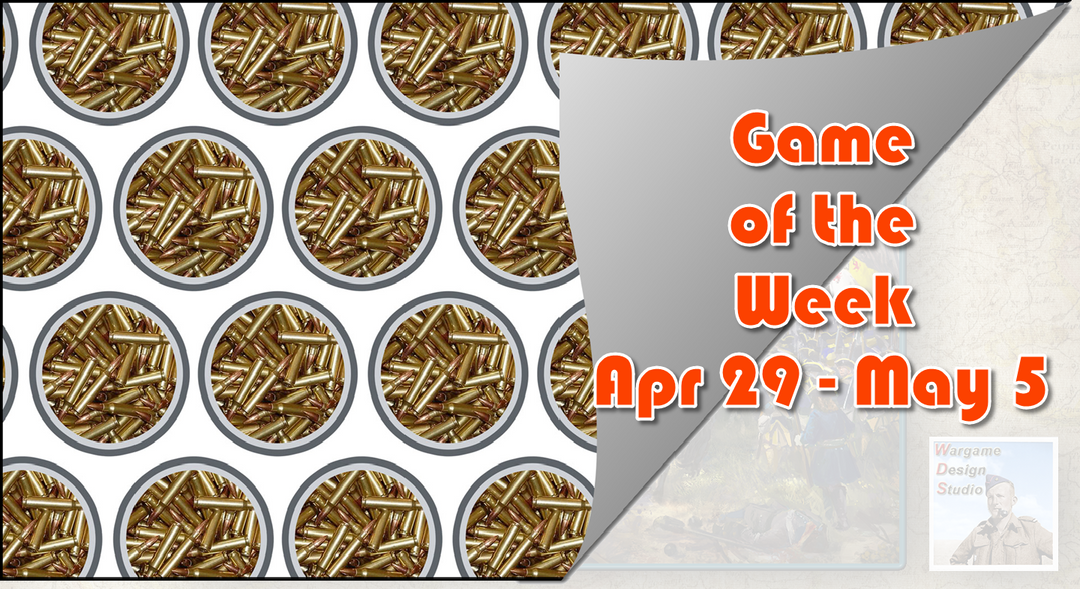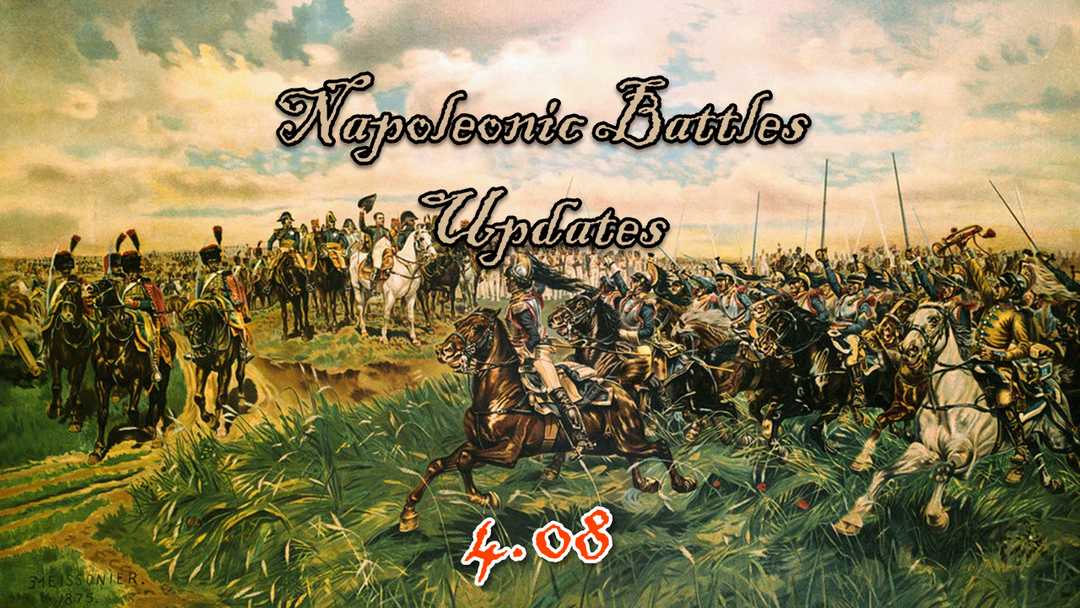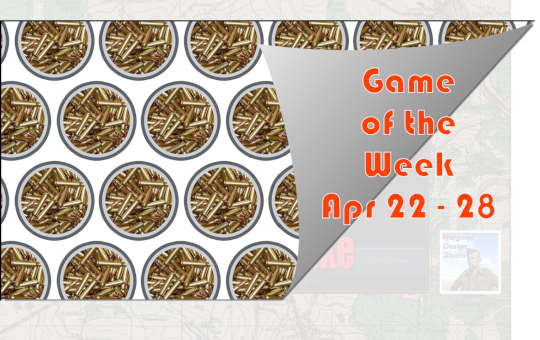Campaigns in the pre-twentieth century titles

In today's post we are going to explore the "Campaign" feature that exists in the various pre-twentieth century game series we offer. Those would be:
We are going to be focusing on the Napoleonic engine for our examples, but pretty much everything I will share with you applies to all the others. The differences that exist primarily relate to the situation being covered or the specific scenario designer's decisions. I'll elaborate on that a bit more as we get into the topic.
The games differ from the format that exists in the Operational games such as Panzer Campaigns, where the "Campaign" is a monster scenario that could potentially encompass weeks - but is all handled on a single map and inside a single scenario. This is primarily due to the Scale of those games - 1 Kilometer hexes as opposed to these games which can be 100 Meter hexes down to 125 Foot hexes. The size of the forces involved are also larger in the WWII titles. In these games being discussed today the Campaign is presented using a separate "Front End" which allows decisions to be made and then a situation to be presented to the player(s) based on these choices. The Campaign Engine is pretty powerful, and flexible, so this description can become a bit winding... I will do my best to make things clear.
In a nut shell, this is the process:
- Start the Campaign Front End.
- Select to start either a new or existing campaign.
- Play the turn & exit the program.
- Email the turn if applicable to your opponent.
- When you get the turn back, place it inside your game and repeat the steps.
What you the player will be presented with can vary from game to game based on the scenario designer's decisions during development. For example, you can be presented with one of the following:
- A "Linked" Campaign where you are presented with a series of choices that will walk you through a series of battles in a given topic. This style can take two formats:
- A "string" of battles move you through a war in chronological order, but losses from the previous battles do not carry over into the next. Rather this is handled through altered OOBs and the force reductions are representative of what happened historically, not what happened in your particular game. This format is used when there's a large amount of time that transpires between battles (as often did) and where the historical armies made significant reorganizations and replenishments between the battles. So, a good portion of the force may not even have been involved in the proceeding battle. Now that is not to say there is no impact from the previous battles, or at least there can be, depending on how the file is constructed - because the outcome of one battle can be mapped in one of 5 ways based on the victory conditions. If the French forces suffer a Major Defeat then the next battle is "X", but if they win a Major Victory then the next battle is "Y". The "American Revolution" campaign included with Campaign 1776 is an example of this style.
- A "true" campaign where you have linked battles and choices, but losses Do carry over, there's a chance of lost stragglers returning to the fold, and if the battle happens on the next day it is also possible for a certain level of Fatigue to carry over. Some situations lend themselves easily to this - and a single OOB can be used... others are more complex and an .org file needs to be created to "map" units between OOB files to ensure losses carry over properly. An example of this, which we will be exploring a bit more in this post is included in Campaign Eckmuhl. In some titles where the topic does not lend itself to this, a Hypothetical Campaign is included which would use historic forces at a given starting point, but then allow you to fight battles that will impact each other. The "1757 Grand Campaign (Hypothetical)" included in Seven Years War is an example of this type.
- A "Campaign in one" that will result in a single scenario - but several potential variants of that situation based on the decisions made by each side. For example, in this case each player will be presented with a matrix of choices... let's say 4 for one, 3 for the other. Each choice provides for a variation on deployment - or possibly a Strategic Decision that would allow more, or less, troops to be involved in the coming battle. This would then yield an outcome of 1 of 12 scenarios being presented for play. That is, if A1 is selected then there needs to be an entry for A1 + F1, then A1 + F2 and so on. The image below illustrates this, which is from Campaign Waterloo.

A further variation on this format is also pictured above. In this example the "wildcard" is used with each scenario (*) that tells the engine to pick from a pool of scenarios with the same file names but variable ending characters. This allows for further variation in regards to arrival times, probabilities or locations of reinforcements for example.
So, again, in a Campaign, both sides get a chance to choose their deployment options before the battle. Depending on the campaign (and the designer who put it together), you may approach a battlefield from a different direction, or possibly even head to an entirely different battlefield. Likewise, the result of the battle will also generally affect the options for the next battle. If the French win, the options and battles available at the next stage of the campaign will reflect that, and likewise, if the Coalition forces win, the next round of choices and battles will reflect that. In fact, since each battle has 5 different potential outcomes, you can end up on five different branches of the tree just from a single battle. An extreme example of what can be done is shown in the hypothetical "Campaign of 1758" from French & Indian War which can potentially yield up to 8 battles, if the victory conditions of each battle play out properly.
It should be noted that every game ships with a "Campaign Editor" and so you, the player, have the tools in your possession to make custom campaigns - and they can be as complex as you wish. However it should be noted that this can be a very complex and time consuming process - but a satisfying one when you create something challenging with good replayability. If you ever do create your own successfully do write us and tell us about it - Helpdesk@wargameds.com
 That's a basic overview of what is offered in campaigns, but how do you access them? It is important to note that you do so with a different program than the "main program" that you use to access the stand alone scenarios. Multiple ways to get to it:
That's a basic overview of what is offered in campaigns, but how do you access them? It is important to note that you do so with a different program than the "main program" that you use to access the stand alone scenarios. Multiple ways to get to it:
The first way is through the Windows Start Menu program group. By default this would be "Wargame Design Studio" and then there will be various icons in that group. With changes to Windows however and based on the number of games you have installed, this can be a bit confusing. Here's is an example of the proper shortcut for the Campaign Front End in Austerlitz:

An alternative way, and probably the best for most users is to use the free Menu Program that you can download from our website, here.
When installed in the proper folder which is the "root" wherever you have your games installed (Default is C:\WDS), the program will pick up all your installed games. And when a game is selected in the left window, the screen on the right is updated with a listing of all the game exe's (listed first) followed by the various pieces of documentation for the game.

Note the entries on the left side of the screen. I have installed my games into sub-folders based on the topic. In this case all of my Napoleonic games get installed to D:\Games\Nap\... and the Menu program is installed to D:\Games - with the result being that all of my games are organized and displayed by series, and then in alphabetical order by title.
For those who are comfortable using File Explorer within Windows there's a third way to access the program - by double clicking on the cp_start.exe file located in the root of the appropriate game folder. This is my preferred method as I'm constantly moving between games, folders, etc. and doing different tasks. I am Always in File Explorer...

Ok, now you know how to start it - what then? Well, let's take a look... we're going to use Campaign Eckmuhl for this example... and we have a related "treat" for you at the bottom of this post.
You will first be greeted by the Campaign Front End screen, which allows you to either start a new campaign or continue an existing one.

If you click on Start New you are presented with a dialog box which lists the available campaigns within the game:

Campaign Eckmuhl includes two types of the previously mentioned campaigns. Two "Linked" campaigns and one "Campaign in one" style. The Eckmuhl In One Battle is obviously the Campaign in one format - this has the players making operational level decisions and it results in one of 9 possible scenarios played out on the huge 325,632 hex master map.
The other two entries are campaigns that do allow losses to carry over. This game covers a relatively tight window of time, in April 1809, and so each battle is closely related. The first entry actually allows you to continue the campaign into the "sister" game, Campaign Wagram - assuming the proper continuation criteria is met.
Ok, for our example here we are going to choose the first entry. Upon doing so we will be prompted to save our game file - which by default will be "campaign.cpf", but you can all it anything you wish. You just need to leave the file extension (.cpf) alone.
Note: If in any game you launch the Campaign Front End and are immediately prompted to save your file with a new name - this is because the game only includes a single campaign (.cpd file) and so the initial choice is by-passed. I *think* this only applies to Napoleon's Russian Campaign at this point, but there might be others.
You are then presented with a window where some decisions need to be made in relation to how the game will be played:

You can play either against the AI or PBEM against another player. And as you see there are two options for how the AI can react. You also choose your desired side to play here.
The "Use Expected Values" is only applicable if you simply want to step through the various decision screens and skip the tactical battles. So, 99% of the time you will not use that option.
The listing below contains all the various decision points you can start from within the campaign. Generally speaking you want to leave the first one selected, but there may be a case where you want to start further into the list for some reason.
This screen is the only time throughout the entire campaign that you will get to make these specific choices. If you need to alter them for some reason you will need to start the campaign over. For this example I am going to choose French & Play-by-E-mail (PBEM) so we can talk about file transfers in a bit. If you are playing against the AI you obviously don't need to send any files to anyone!
Next you are presented with a series of screens. The first is the "Overview" screen which... gives you a high-level view of the situation you are entering. In this particular case there are notes about continuing into Wagram at the top of this first screen too. The next screen give you the situation - where the campaign will begin. Also an information only screen, but important.

Both the Situation and the following Decision screens will be displayed with each new "branch" within the campaign. So you will get an overview of the situation and then be given choices at each point. In some cases, you only get a single option, like this first point at Landshut, but in others you will often have two, or more.

Up unto this point things are the same between playing against the computer or a human opponent. If against the computer, the game would simply launch into the tactical battle and away you go. For PBEM however we now need to send the file to our opponent so that they also get the Situation brief and the ability to make their own decision. Accordingly, you will get a pop up box that says:

You click OK and the game returns you to the original Front End screen.
Remember when I was talking about using File Explorer all the time? Well, it's time to go back into it - at least it is for me. Depending on the email program you use you could do everything from there... let me explain.
Now you need to transfer the .cpf file you named earlier to your opponent. I am going to share a few steps with you about how I do things - you can adjust to your own liking, but I think these items are worth considering.
File Explorer can be accessed from your Taskbar by clicking the file folder picture to the right of your search bar in Windows 10.

Two important changes I make to Windows Explorer right away. I set it to Show file extensions - which is the . followed by three letters - which tells both you and your computer what the file is for. I also prefer to use the "Details" view to show me things like Date/Time stamp and file size, as well as the full file name. These settings are accessible from the View menu at the top of the screen.

So here's what I am looking at. Note that we are inside the games folder structure. The folder we want to go to is the \Saves folder and then we want to find our .cpf file. Note: for the EAW series of games they do not have a \Saves folder, so the game turns are stored inside the main game directory.
 As you have more activity you will have more files in this folder. Not only in-process game files, but also supporting files and temporary working files. To help you define that a bit here's a list of files you might see in this folder:
As you have more activity you will have more files in this folder. Not only in-process game files, but also supporting files and temporary working files. To help you define that a bit here's a list of files you might see in this folder:
.cpf - in-process campaign game file. (Only one to transfer)
.btc - supporting file from the campaign.
.bto - supporting file for the campaign.
.bte - single-battle PBEM file.
.btl - single battle against the computer.
.btt - hot-seat battle.
pbemail.xxx - temporary working file.
pbemail.yyy - temporary working file.
Both of the temp files can be safely deleted periodically when the game is not running, if you so desire.
So, I'm off on a bit of a rabbit trail here I know, but I want to share this with you. You could simply send the .cpf file off to your opponent, they do their turn, and when you get the file back you just copy it back into this folder and proceed. However, I have learned from hundreds of PBEM matches over the years to - expect the unexpected. What I mean by that is a file could get corrupted in transit. Your opponent might send the wrong file back. You might accidentally delete the good file from your game directory, and on... so I have developed my own backup system to manage files to prevent loss.

I simply copy the completed game file into one of the three numbered folders each time I complete a turn. And I cycle through them, 1, then 2, then 3, then back to 1 and so on. This way, if a problem arises I can simply grab the last file and resend it. And if by some chance that is corrupted I have 2 others to go to as well. A little extra mouse work, but if it saves me, or my opponent, from having to redo a game turn - it's worth it.
Note: While another extra step, it is highly recommended that you "zip" your game turns when emailing them. This reduces the chance of file corruption over the web. There is the free built in utility to Compress within Windows. There's also programs like WinZip, 7-Zip, WinRAR and so forth.
It is possible to go into your email, start a new email, then "Browse" to the game folder and select the proper .cpf file if you wish. This of course bypasses the "backup" process I outline, but you can do it.
Ok, back to the campaign!
You have sent the cpf file off to your opponent for them to do their portion. If their army is the first side in the scenario the game will start with them, otherwise the file comes back to you. When you get the file back you copy the .cpf file into your \Saves folder - this must be done in order to access it. Personally I overwrite the existing file - as I have multiple other backups, as I covered above. Then you go back to the Campaign Front End and this time you select the "Continue Old Game" option.
You are given a dialog to select the game file, you do so - then you are given a message about the results of your two choices and then the game launches. You are then presented with this screen - and it only shows on the first turn of each new battle in the campaign:

Leave the AI selection on Manual, but the real important part is the Rules button. This is where you select the optional rules which will be used for the battle. Just like for a single battle, this can only be changed at the beginning of the battle. Additionally, it defaults to the last rule set used on the computer the battle is started on. So, the rules should be reviewed each time a campaign scenario begins to ensure you are using the rules you both agreed to when starting. This is doubly important when one side starts the first battle, but the second player happens to start the next. Bottom line - review the rules prior to starting the game.
Click OK - you will either go into your first turn, or a dialog box will appear saying the local control has ended. All that means is the game file now needs sent you your opponent. Those same two dialogs will appear at the end of each turn thought the process.
From this point on it is a normal PBEM match with game files being transferred back and forth. Until the battle reaches a conclusion and you return to the Situation / Decision process.
One item worth mentioning is contained in the "Modes" menu within the game. If you reach a point where you want to move on to the next battle, for what ever reason, you can use the Termination Bid feature. When playing against the AI the computer will take whatever victory level you choose and immediately move on. If in PBEM your opponent has to respond to and accept the proposed victory level offered. Once done the game moves on to the next battle if applicable.

Ok, that completes our review of the campaign feature - what it is & how to use it. Again, this is a core component of all the games in the following four series.
Ok, now for the treat I mentioned earlier. We are releasing today, on our YouTube channel, a series of videos on the early part of the playthrough of this Eckmuhl Campaign. Alex submitted these, and like the Introduction article series he did, he's done a fine job with his presentation. He chronicles how his Austrians steamrolled my French forces in the first two scenarios of this 1809 campaign. We are currently paused while I work on the next round of updates for the series, but this cycle may continue in the future.
I am just going to redirect you to our YouTube channel to watch them, since it's a whole series - rather than embedding here. All are short - ranging from 3 minutes to the longest being 13 minutes. We feel it will really give you a "flavor" of what the campaigns have to offer - better than just the written word.
If you like these videos and want to see more please subscribe to our YouTube channel and also let us know by your comments.
We hope you have found today's post useful and that you will venture into the campaigns in the near future!






Great post! I too am a long time PzC & MC player who wants to have a crack at some of the earlier period titles, and to that end I’ve bought Waterloo. This post and the videos will really help with getting me up to speed. Thank you!
Thank you for your ongoing and most informative Blog posts.
So far I’ve tried one Campaign. The 388move Campaign Waterloo which I played PBEM. I got quite involved and even printed out a giant A2 Map of my progress.
Problem was I was new to Napoleonic and was soon out of my depth trying to handle Napoleons massive army. Eventually my opponent tired of my blundering about and moved down to meet me, and it became the “Battle of Charleroi” rather than Waterloo!
By turn 80 or so, not wanting my opponent to play or a year knowing he would win anyway, I packed it in. However I thoroughly enjoyed the whole experience and brutal learning curve!
I enjoy these blogs and the supplementary videos. The essence of these campaigns can be worked out with the software, but its nice to have walkthrough of the situations. cheers
Thanks for this. As a longtime PzC player who wants to try the earlier period games, it was really helpful.
I’ve been playing pbem in club settings for over 24 years now going back to the original Talonsoft and I think the original (?) Campaign Series 1776 (1999?), but I can’t recall ever playing a pbem campaign. It looks interesting and I’d like to try one someday, and this is good information to assist with that.
Leave a comment